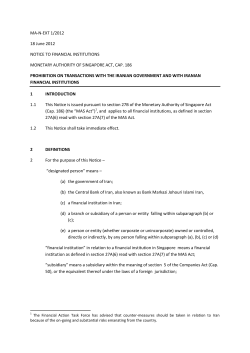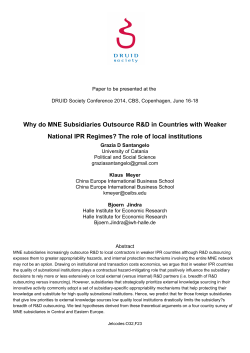
Sample Barry Smith ACCA F7 notes IAS 27 Barry Smith
Sample Barry Smith ACCA F7 notes IAS 27 Barry Smith Page 1 of 8 2010 Group accounts – IAS 27 1. Objective of a consolidation process Where P is and individual legal entity and S is an individual legal entity, if P controls S, then in substance they form a single economic entity. This is referred to as a group. The essential feature of a group is that one entity controls all the others. Financial statements are prepared as if they are the accounts of a single entity. IAS 27 applies to the preparation and presentation of consolidated financial statements for a group of entities under the control of a parent. IAS 27 also applies to the accounting for investments in subsidiaries, jointly controlled entities and associates in the separate financial statements of a parent. Illustrative example of consolidating statements of financial position Statement of financial position Assets Investment in subsidiary (100%) Other assets Liabilities Equity Ordinary share capital Reserves parent subsidiary 40,000 58,000 98,000 40,000 40,000 adjust group (40,000) 0 98,000 98,000 (40,000) 14,000 70,000 14,000 98,000 14,000 40,000 (40,000) 40,000 (40,000) 70,000 14,000 98,000 The parent investment is in the equity of the subsidiary. From the perspective of the individual reporting entities, the parent investment and the subsidiary equity arise from transactions with parties that are outside each reporting entity. However, from a group perspective, the parent and subsidiary are, in substance, part of the same reporting entity so there is no transaction with an external party. For this reason, the parent investment is cancelled against the subsidiary investment. Barry Smith Page 2 of 8 2010 2. Definitions Parent: An entity that has one or more subsidiaries. Subsidiary: An entity that is controlled by a parent. Group: A parent and all its subsidiaries. Consolidated financial statements: single entity. The financial statements of a group presented as those of a Control: The power to govern financial and operating policies so as to obtain benefits from its activities. For exam purposes, control is reasonably presumed (in the absence of other information) if the parent has 50% or more of the voting power. Control may also be evident from power to: • • • Govern the financial and operating policies under statute or agreement Appoint or remove the majority of the board of directors Cast the majority of votes at meetings of the board of directors Potential voting rights that are currently exercisable through share warrants, options or convertible debt or equity instruments should be taken into consideration when assessing one entity controls another. Non-controlling interest: indirectly, to a parent. The equity in a subsidiary that is not attributable, directly or Separate financial statements: Financial statements presented by a parent in which the investments are accounted for on the basis of direct equity interest rather than on consolidated basis i.e. reported results and nets assets of the subsidiaries. Barry Smith Page 3 of 8 2010 3. Requirement to prepare consolidated financial statements A parent is required to prepare consolidated financial statements in accordance with requirements of IAS 27 except if all of the following apply: • • • • Parent is itself 100% subsidiary or parent is partially owned by another entity and owners do not object to the parent not preparing consolidated financial statements Parent’s debt or equity instruments are not publicly traded Parent has not filed nor is in the process of filing financial statements with a securities commission for the purpose of going public Ultimate or intermediate parent produces consolidated financial statements in accordance with IFRS and are available for public use. A parent that, based on the above possibilities, elects not to produce consolidated financial statements, presents only separate financial statements in accordance with IAS 27. 4. Exclusion of subsidiary from consolidation If consolidated accounts are to be prepared, then all subsidiaries must be included except if: • • There is a loss of effective control (account for the investment in accordance with IAS 39); or The subsidiary is acquired but is to be immediately re-sold (account for the investment in accordance with IFRS 5) 5. Co-terminus period ends IAS 27 permits use of financial statements made up to a date not more than three months earlier or later than the parent’s reporting date. Adjustments are required for significant transactions or events between the dates. 6. Uniform accounting policies All group entities should have the same accounting policies. Where necessary, financial statements of group member must be adjusted to achieve consistency of accounting treatment within the group accounts. Barry Smith Page 4 of 8 2010 7. Consolidation procedures (i) Parent and subsidiaries are combined on a line by line basis for income, expenses, assets, liabilities and equity. Parent’s investment in each subsidiary and the corresponding equity in each subsidiary are eliminated. Illustrative example of a consolidation Parent acquires 100% of Subsidiary on date of incorporation of Subsidiary at the nominal value of Subsidiary’s ordinary share capital. There are no transactions between Parent and Subsidiary other than the investment by Parent in Subsidiary. Statement of comprehensive income Income parent 10,000 subsidiary 2,000 adjust group 12,000 Expenses 4,000 400 4,400 Profit for the period 6,000 1,600 7,600 The group amounts are the sum of the Parent and Subsidiary amounts on a line by line basis. The parent’s investment in Subsidiary is eliminated against Subsidiary equity. Statement of financial position Assets Investment in subsidiary (100%) Other assets Liabilities Equity Ordinary share capital Reserves Barry Smith parent subsidiary 40,000 58,000 98,000 41,600 41,600 adjust group (40,000) 0 99,600 99,600 (40,000) 14,000 70,000 14,000 98,000 Page 5 of 8 14,000 40,000 1,600 41,600 (40,000) (40,000) 70,000 15,600 99,600 2010 (ii) Intragroup balances and transactions are eliminated. Illustrative example of the elimination of intragroup balance and transactions Parent acquires 100% of Subsidiary on date of incorporation of Subsidiary at the nominal value of Subsidiary’s ordinary share capital. Parent invoices €200 of goods to Subsidiary during the current reporting period. Amounts are due to/from Parent/Subsidiary at the reporting date. There is no inventory on hand at the reporting date. Statement of comprehensive income Income from subsidiary Other income Income Parent 200 9,800 10,000 Subsidiary 2,000 2,000 adjust (200) (200) (200) group 0 11,800 11,800 Expenses charged by Parent Other expenses Expenses 4,000 4,000 200 200 400 (200) 0 4,200 4,200 Profit for the period 6,000 1,600 0 7,600 adjust group (40,000) (10,000) 0 0 99,600 99,600 The intra-group income, expenses, receivables and payables are eliminated in full. Statement of financial position Assets Investment in subsidiary (100%) Trade receivable from Subsidiary Other assets Liabilities Trade payable to Parent Other liabilities Equity Ordinary share capital Reserves Barry Smith Parent 40,000 10,000 48,000 98,000 Subsidiary 51,600 51,600 (50,000) 10,000 (10,000) 14,000 14,000 10,000 (10,000) 70,000 14,000 98,000 40,000 1,600 51,600 (40,000) Page 6 of 8 (50,000) 0 14,000 14,000 70,000 15,600 99,600 2010 (iii) Unrealised intragroup profits are eliminated. Illustrative example of the elimination of unrealised profit arising from intragroup trading of inventory Parent acquires 100% of Subsidiary on date of incorporation of Subsidiary at the nominal value of Subsidiary’s ordinary share capital. Parent sells goods to Subsidiary during the current reporting period. The invoice price is €200. Parent’s profit on the transaction is €100. All this inventory is still on hand in accounts of Subsidiary at reporting date. There were no amounts due to/from Parent/Subsidiary at the reporting date. Statement of comprehensive income Income from subsidiary Other income Income Parent 200 9,800 10,000 Subsidiary adjust (200) 2,000 2,000 (200) group 0 11,800 11,800 2,000 (200) 100 (100) 2,000 (100) 1,900 Purchase of inventory Less closing inventory Cost of sales 2,000 200 (200) 0 Other expenses Expenses 2,000 2,000 200 200 0 2,200 2,200 Profit for the period 6,000 1,800 (100) 7,700 The intragroup sales are purchases are eliminated. The closing inventory valuation is adjusted to reflect the cost of the inventory to the group. The cost to the group is the cost of inventory at the point at which it entered the group – this occurred when Parent purchased the inventory. Statement of financial position Assets Investment in subsidiary (100%) Inventory Other assets Liabilities Equity Ordinary share capital Reserves Barry Smith Parent Subsidiary 40,000 58,000 98,000 200 41,600 41,800 adjust group (40,000) (100) 0 100 99,600 99,700 (40,100) 14,000 70,000 14,000 98,000 Page 7 of 8 14,000 40,000 1,800 41,800 (40,000) (100) (40,100) 70,000 15,700 99,700 2010 Illustrative example of the elimination of unrealised profit arising from intragroup transfer of a noncurrent asset Parent acquires 100% of Subsidiary on date of incorporation of Subsidiary at the nominal value of Subsidiary’s ordinary share capital. At the beginning of the current reporting period, Parent sells a noncurrent asset with a carrying value of €24,000 to Subsidiary for €30,000. At the end of the current reporting period, subsidiary depreciates the noncurrent asset using a 10% straight-line method. . There were no amounts due to/from Parent/Subsidiary at the reporting date. The consolidation is as follows: Statement of comprehensive income Income parent 10,000 subsidiary 7,500 Profit on disposal of asset Depreciation Other expenses 6,000 (4,000) (3,000) (400) Profit for the period 12,000 4,100 adjust (6,000) 600 (5,400) group 17,500 (2,400) (4,400) 10,700 Parent’s profit on disposal of €6,000 is the difference between the proceeds of sale (€30,000) and the carrying value at the date of disposal (€24,000). Because the sale of the noncurrent asset is to another group entity, the profit on disposal is unrealised. It must therefore be reversed. Statement of financial position Assets Noncurrent asset Investment in subsidiary (100%) Other assets Liabilities Equity Ordinary share capital Reserves parent subsidiary adjust group 27,000 (5,400) (40,000) 21,600 40,000 58,000 98,000 25,000 52,000 (45,400) 14,000 70,000 14,000 98,000 83,000 104,600 14,000 40,000 12,000 52,000 (40,000) (5,400) (45,400) 70,000 20,600 104,600 The depreciation charge of €3,000 is based on a depreciable amount of €30,000. However, the depreciation charge in the consolidation should be based on the depreciable cost to the group, which is €24,000. In other words, depreciation should be based on the cost incurred at the point at which the noncurrent asset entered the group – this occurred when Parent acquired the asset. On this basis, the correct depreciation charge for the group is €2,400 (€24,000 x 10%). An adjustment of €600 is therefore required to reduce the amount of the depreciation charge. Barry Smith Page 8 of 8 2010
© Copyright 2025












